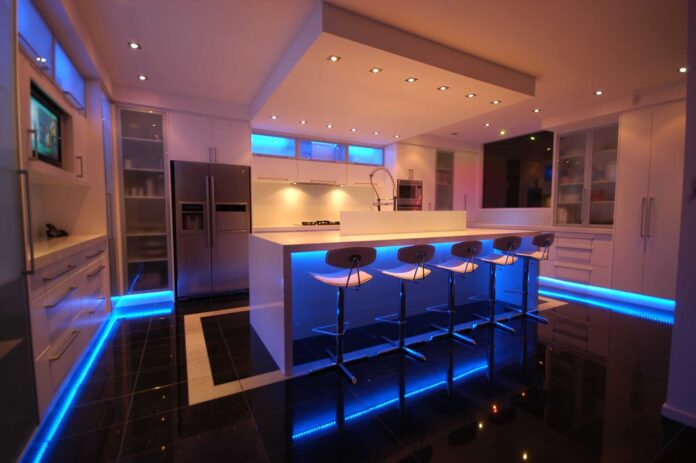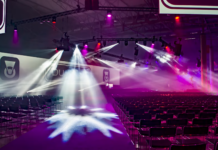Kitchens are not just functional spaces for cooking and eating; they are the heart of the home. A place of warmth, chatter, and, most importantly, sustenance, the kitchen is a sanctuary for family and friends.
The lighting in your kitchen doesn’t just help you see what you’re chopping or cooking; it sets the mood and atmosphere.
In this blog post, we will explore the significance of light color in the kitchen, different types of light you might consider, and some frequently asked questions to help you illuminate your kitchen in the best possible way.
The Psychology of Color in Lighting
The psychology of color isn’t just applicable to the hues on your walls; it also has a bearing on the color of your light. Let’s take a closer look.
Emotional Impact
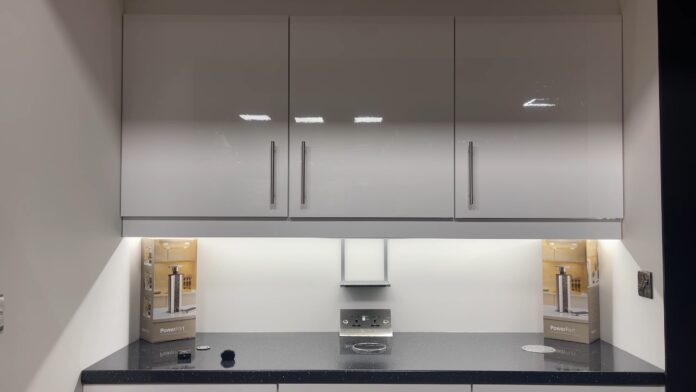
The colors in our environment have a noted impact on our emotions and behavior. Bright white or cool lights are associated with focus and clarity and are often used in offices or study rooms.
On the other end, warm colors like soft white or yellow are linked to relaxation and coziness, making them ideal for living rooms and bedrooms.
So, when it comes to your kitchen, choosing the right color light can affect not just the visual aesthetic but also how you feel when you’re in the space.
Productivity and Functionality

The kitchen is a versatile space that serves multiple functions. It’s a workspace for meal preparation, but it’s also a gathering spot for family and guests.
If your kitchen also doubles as a dining space, you might need versatile lighting that can adapt to different needs.
A bright, white light is often recommended for cooking as it aids in accurate color recognition for ingredients.
On the other hand, you might prefer softer, warmer lights for when you’re sipping wine at the kitchen island or enjoying a casual meal with family.
Aesthetic Considerations
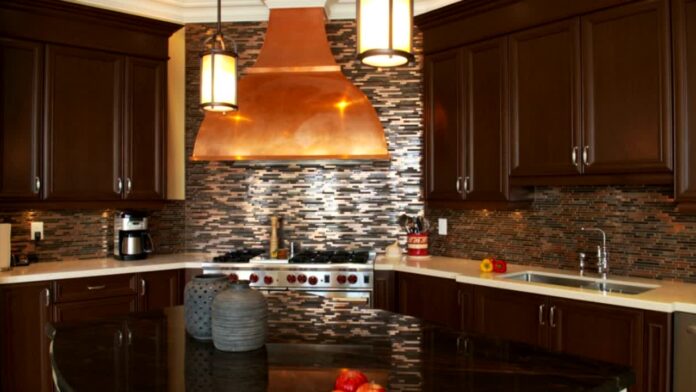
We can’t talk about light color without touching on aesthetic appeal. In modern kitchen designs, the lighting doesn’t just serve a functional purpose; it’s also a design element.
Whether you’re going for an ultra-modern look with sleek LED strip lights or prefer the rustic charm of Edison bulbs, the color of the light will play a critical role in achieving your desired look.
Some prefer the stark, modern appeal that cool white lights offer, while others look for the warm, inviting glow of soft white bulbs to complete a cozy, farmhouse-style kitchen.
Types of Light to Consider
Lighting isn’t a one-size-fits-all proposition, especially in a multifunctional space like the kitchen. Here’s a primer on the different types of light you can incorporate.
Task Lighting
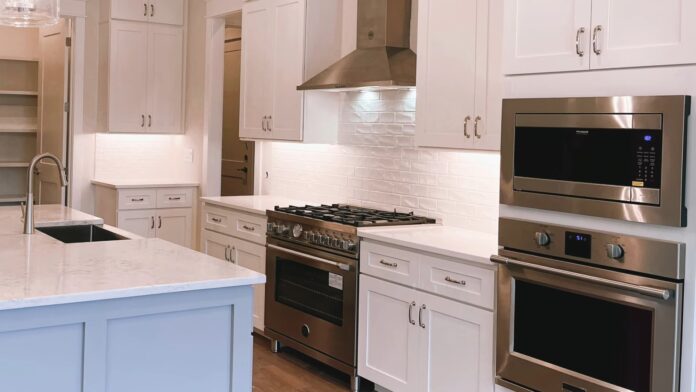
Task lighting is crucial in the kitchen, particularly in areas where you’ll be chopping, slicing, and reading recipes.
Bright, white light is usually the go-to option for task lighting. It allows you to see what you’re doing clearly, making your kitchen tasks safer and more efficient.
LED lights are often preferred for this purpose as they are energy-efficient and have a long lifespan.
Ambient Lighting
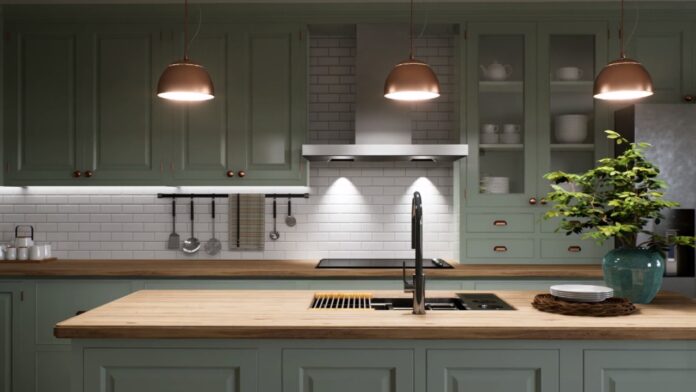
Ambient lighting is the general lighting that fills the room. In most kitchens, this can be a combination of natural daylight and artificial light.
Warm lights are usually preferred for ambient lighting to create a welcoming environment.
This is often achieved through a combination of ceiling lights, wall sconces, and even floor lamps in larger kitchens. When choosing ambient lighting, think about the overall mood you want to set in your kitchen.
Accent Lighting
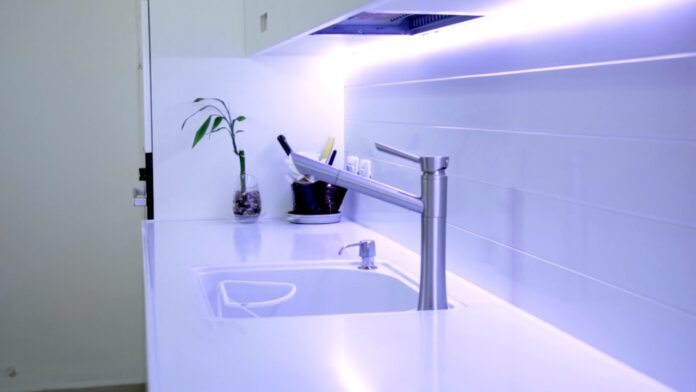
Accent lighting is used to highlight certain features or areas of your kitchen, such as artwork, open shelving, or architectural details. The color of accent lighting depends largely on what you’re trying to achieve.
Warm lights can draw attention to features in a cozy, inviting manner, whereas cool lights can create a striking, modern contrast.
Popular options for accent lighting include recessed lights, track lighting, and LED strip lights.
The Importance of Layering Lights
We’ve talked about different types of lighting, but what about using them in tandem?
Layering different types of lighting is essential for creating a dynamic, versatile kitchen environment. Let’s talk about how to effectively layer lights in your kitchen.
The Basics
Layering lights in your kitchen involves using a variety of light sources to create a well-balanced and functional lighting scheme.
Typically, this involves using a combination of ambient, task, and accent lighting. Ambient lights serve as the base layer, providing general illumination for the kitchen.
Task lighting serves the functional aspects, specifically where you need focused light for cooking, reading, or other activities.
Accent lighting, the third layer, adds a decorative touch, highlighting specific architectural features or artwork.
Tips for Effective Layering
Effective layering is not just about adding multiple light sources; it’s about placing them strategically to serve specific purposes.
For instance, under-cabinet lighting can serve as task lighting, illuminating your countertop activities, while a pendant light over the dining area can function as both ambient and accent lighting.
Dimmer switches can also be highly effective in creating versatile lighting environments, allowing you to adjust the light intensity according to different needs and times of the day.
Common Mistakes to Avoid
Layering lights is an effective way to create a versatile and dynamic kitchen, but there are common mistakes you should avoid.
One such mistake is over-illuminating the space, making it uncomfortably bright. On the opposite end, inadequate lighting can create dark spots and shadows, making your kitchen less functional and inviting.
Another mistake is ignoring the color temperature. Mixing warm and cool lights without a strategy can create a disjointed appearance, disrupting the kitchen’s overall aesthetic.
Sustainable Lighting Options
As sustainability becomes more critical, choosing eco-friendly lighting options is a consideration that should not be overlooked.
Let’s take a look at some sustainable options that are both functional and kind to the environment.
LED Lights
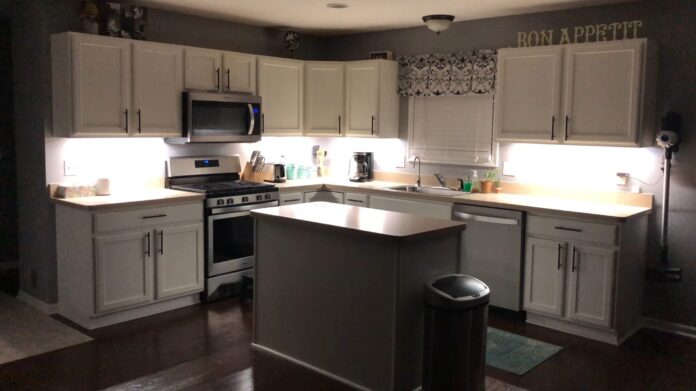
LED (Light Emitting Diode) lights are at the forefront of energy-efficient lighting. They consume less electricity and have a longer lifespan compared to traditional incandescent or halogen bulbs.
LEDs are also versatile and available in a range of color temperatures, making them an excellent choice for various kitchen activities.
They are slightly more expensive upfront but offer long-term cost savings due to their longevity and energy efficiency.
Smart Lighting Systems
Smart lighting systems offer another layer of energy efficiency and convenience. These systems allow you to control the lighting in your kitchen through a smartphone app or even voice commands, providing options to dim or switch off lights when not needed.
Some smart lighting systems also come with features that adjust the light’s color temperature, allowing you to switch between warm and cool lights as needed.
Solar Tubes and Skylights
If you’re looking to capitalize on natural lighting, solar tubes and skylights are excellent options. Solar tubes funnel sunlight from the roof into your kitchen, providing natural daylight without the heat usually associated with direct sunlight.
Skylights, on the other hand, are larger and can be opened for ventilation. While the initial cost of installing these features can be high, they can significantly reduce your reliance on artificial lighting during the day, cutting down your energy costs.
FAQs
How Do I Choose Between Warm and Cool Lights?
Choosing between warm and cool lights depends on both functional needs and aesthetic preferences. If your kitchen is primarily a workspace where you do a lot of cooking and meal prep, a brighter, white light is a practical choice.
However, if you do a lot of entertaining and dining in your kitchen, a warmer light might better suit your needs. Many people opt for smart lighting systems that allow for adjustable color temperatures, offering the best of both worlds.
What is Color Temperature and How Does it Affect My Choice?
Color temperature is measured in Kelvin (K). The lower the Kelvin number, the warmer and more yellow the light.
For example, a light with a temperature of around 2700K will emit a warm, yellowish light. A light that is 5000K or higher will produce a much cooler, almost blue light.
Knowing the Kelvin number can help you make a more informed choice about the right color light for your kitchen.
Are There Health Implications to Consider?
Interestingly, the color of light can have some impact on our circadian rhythm. Exposure to bright, blue light in the evening can interfere with the body’s production of melatonin, the hormone responsible for sleep.
On the flip side, warm light is less likely to interfere with sleep patterns and is often recommended for use in the evenings.
If you’re someone who spends a lot of late nights in the kitchen, you may want to opt for warmer, softer lighting to minimize any potential disruption to your sleep cycle.
Can Different Color Lights Affect the Color of My Food?
Yes, the color of the light can affect how the color of your food appears, although it doesn’t change the food itself.
For instance, under a very warm, yellowish light, a green apple might look duller than it actually is. On the other hand, a cool, bright white light might make the same green apple appear more vibrant.
If presenting food in the most appealing manner is a priority for you, opting for a light closer to natural daylight (around 5000K) is usually recommended for the most accurate color representation.
Is there a Specific Wattage Recommended for Kitchen Lights?
Wattage mainly indicates energy consumption and not brightness. In the past, we used to correlate the brightness of a bulb with its wattage, but with the advent of LED technology, you can now get the same brightness for significantly lower wattage.
For task lighting, look for bulbs that offer around 800 lumens or higher for sufficient brightness. Ambient and accent lighting can vary, but 300 to 600 lumens per fixture is a good general guideline.
Do Light Colors Have an Impact on Energy Efficiency?
The color of the light itself doesn’t significantly impact energy efficiency; it’s more about the type of bulb you’re using.
LED bulbs are the most energy-efficient option, regardless of the color temperature you choose.
However, perceptions of brightness can differ with color, meaning you may feel like you need less artificial light when using cooler, bright white lights as compared to warm lights.
How Can I Test Different Light Colors Before Making a Decision?
Many modern lighting fixtures allow you to change the color temperature of the bulbs either through a switch on the fixture itself or through a smartphone app.
You can also purchase individual adjustable color temperature bulbs to test in your existing fixtures.
Alternatively, you can buy small, inexpensive bulbs in various color temperatures and swap them out to see which you prefer in different settings and times of the day.
What is CRI and How Does it Affect My Choice of Kitchen Lighting?
CRI stands for Color Rendering Index, which measures the ability of a light source to reveal the colors of objects faithfully in comparison to natural light.
A high CRI (closer to 100) is generally desirable in the kitchen, especially for task lighting, as it allows for more accurate color discrimination.
This can be particularly important in tasks that require color precision, like cooking and food preparation.
Are there Specific Brands that Offer Better Choices for Kitchen Lighting?
There are several reputable brands known for their quality kitchen lighting options, such as Philips, GE, and Cree for LED bulbs, and Lutron for smart lighting systems.
Each of these brands offers a range of color temperatures and types of lighting suitable for kitchen use.
While brand reputation can be an indicator of quality and durability, the best choice for you will depend on your specific needs, aesthetic preferences, and budget.
Final Words
Choosing the right color light for your kitchen is an essential part of the design process. Not only does it affect the functionality of your space, but it also plays a significant role in setting the mood and atmosphere.
Whether you’re renovating your kitchen or building one from scratch, thoughtful consideration of light color and type can make your kitchen not just a workspace but a welcoming hub for family and friends.
From understanding the psychology of color to selecting sustainable options, this guide aims to illuminate the various aspects of kitchen lighting, ensuring that you make an informed decision that suits your lifestyle and aesthetic preferences.

